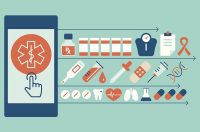
As per the IQVIA Institute for Human Data Science's Report, the number of mHealth apps has surpassed 350,000. Most cover general health and wellness concerns or help track habits. Due to the pandemic's irreversible effects, many conditions and diseases emerge dynamically. Thus, many applications have started targeting them.
The mobile health business is expanding faster than ever before. Diving into mHealth app development helps improve care quality and speed up research. Keep reading to discover the costs of creating digital health tools.
Factors Impacting Development Costs
Digital healthcare products and tools differ depending on the purpose. The most common categories are:
General Health & Wellness Tools
- Nutrition-tracking and fitness apps;
- Sleep, mindfulness, and stress-management applications;
- Women's health;
- Mind training, education & productivity apps.
Professional Healthcare Tools
- Electronic Health Records;
- Remote monitoring apps;
- Telehealth (doctor-on-demand) apps;
- Consulting & appointment scheduling apps;
- Professional networking apps;
- Medical database apps;
- Condition-specific apps.
Besides the objective, the costs depend on tools, architecture, regulations, and developers. Let's explore each factor in more detail.
Design
A well-designed mHealth app leaves no space for confusion. It navigates users smoothly, provides the necessary information clearly, and encourages action. Before approaching app design, evaluate the target audience's (TA) to estimate costs. In further development stages, expenses vary based on:
- Android & iOS design specifications;
- App's accessibility for users with special needs;
- Notification content & design;
- Navigational structure & components;
- Personalization options;
- Chosen color scheme.
It's important to consider scalability in the early design stages. The product must fulfill users' needs. Then, assessing adjustments saves money once the audience expands.
Features
Health apps succeed if there's a concrete purpose and clear answer to "What is this mHealth tool used for?" Analyzing essential features and TA requirements helps formulate the app's concept and costs.
| Application Type | Features |
| Medical reference & database | – Search by category & filter;
– Drugs & diseases information;
– Visual materials on procedures & diseases;
– Medical research & publications;
– Calculator;
– Tests & quizzes. |
| Professional networking apps | – File & image sharing;
– Real-time chatting;
– Journals & personal notes;
– Relevant content;
– Updates on events. |
| Patient tracking apps for medical experts | – Access to EHRs;
– Patient information;
– Lab orders & results;
– Prescription management;
– Notifications (health updates). |
| Consulting & appointment apps | – Health provider search;
– Doctor specialty, location & availability search options;
– Healthcare insurance;
– Access to doctors' calendars;
– Appointment booking;
– Payment integration. |
| Telehealth apps | – User profiles;
– Voice & video interaction, chats;
– Image & document exchange;
– Prescription management;
– Payment integration. |
Platform
The chosen platform integration method helps utilize the app's assets fully. Possible options include:
- native app development. There are separate languages for iOS and Android. These are Java or Kotlin for Android and Objective-C or Swift for iOS. Developing separate applications prevents functional errors and allows for adjustments whenever necessary. The downside: native development requires more time, money, and effort.
- Cross-platform development. This solution enables building applications for many platforms reusing the same code. It's less expensive, and you also don't need to hire many developers. However, cross-platform apps tend to be more sluggish, less user-friendly, and limited in functionality.
Though cross-platform development seems faster to implement, it's more likely to have shortcomings. Over time, this causes expenses. Conversely, native development is more reliable but also costs more. A cost-effective decision lies within the understanding of the application's purpose and features.
Time Spent on Development
Development duration relies on the solution's complexity and difficulties emerging in the process. It's nearly impossible to predict the final expenditure. Still, calculating approximate spending is easier. Consider these factors:
- Audience & usability evaluation. Initial target audience analysis and feedback collection helps determine the product's key functions. You will also be able to avoid unnecessary tweaks. This helps picture user experience, define end value, and make adjustments on the go.
- Repeated iterations. Testing payment integration, media files sharing, and real-time interaction occurs in cycles. The more complex the function, the higher the number of trials.
- Developers' expertise in building innovative solutions. Active expansion of the mHealth market prompts developers to follow the latest trends. Proper understanding of user demand, the current environment, and forecasting require more time for implementation.
Team Size
In development, bigger teams imply higher expenses. Increasing the number of team members makes sense during later development stages. For example, when the product's concept is introduced and attracts investors. Yet, bigger teams don't automatically mean increased productivity and efficiency.
Team size is situational and represents one factor of the project management triangle:
The three shape quality. Team size is an integral element, subject to change depending on other factors. With one developer, the application takes more time to finish but costs less. A bigger project scope with less available time will likely produce poor results. Evaluating the available resources and project background helps choose an optimal option.
Regulations and Compliance
Launching mHealth apps requires expenses linked to conformity with policies and regulations. The main compliance factors affecting development costs are:
| Governmental institutions | — The EU: General Data Protection Regulations (GDPR);
— The US: Health Insurance Portability and Accountability Act (HIPAA); |
| Application stores | Google Play Store & Apple App Store require compliance to protect users. Developer fees are:
— $25 for Google Play Store developers;
— $99 (Individuals & Basic Organizations) & $299 per year (Enterprise) for Apple App Store developers. |
| In-app security measures | — End-to-end encryption;
— Multi-factor authentication;
— Limited session time. |
Development Costs for mHealth Apps
Considering the factors above, development costs approximate to:


No comments:
Post a Comment